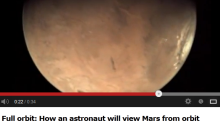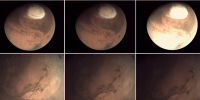Help us with the VMC!
Students, teachers, scientists, photographers and the general public are invited to help us process the images, remove artifacts, increase sharpness and interpret what the images show. And if you have success, send us a copy – we’ll publish the best submissions right here in the VMC site!
Processing images
Colour information
You are invited to process the binary image files to extract the colour versions. Every VMC image has colour information overlaid as a Bayer pattern grid on the image (see FAQ Question 3). There are two levels to which you could process: (1) to remove the effect of the filter from the image without losing detail; and, (2) use the pattern to extract colour information from the image.
Gordan Ugarković, one of the VMC contributors wrote an excellent script to perform the colour extraction which can also be used. You can find this and much more discussion of VMC image processing at the unmannedspaceflight.com forum.
Artifact removal
Virtually all of the VMC images contain artifacts; some are caused by undetermined hardware or software issues; some are possibly caused by scratches or marks on the optics. It would be worth processing some of the better images to obtain artifact-free versions or determining a systematic method for removing these from VMC images.
Sharpness, brightness, contrast
Again, some of the better images could be processed to improve the sharpness, focus, brightness or contrast. Examples of what could be done include combining several images of different exposures from a sequence to create one ‘High-dynamic range’ image (with no areas of over- or under-exposure). Several of the sequential image sets could also be combined using a technique such as the popular astronomical ‘stacking’ method to produce an improved ‘super-image’.
Animations
Many of the sequential image sets could also be combined to create an animated version – either an animated GIF or an actual video. These animations could show, for example, the spin of the planet during an observation, or weather patterns (example here).
Interpretation – what do you see?
We invite keen scientists of all ages to help us interpret the VMC images.
- What do you see?
- What portion of Mars’ surface is visible? Can you estimate the latitude and longitude?
- Can you identify any geographical features?
- What regions of the atmosphere or atmospheric components do you see?
- Why are any regions of the image blurred or why is nothing visible – was it strictly due to illumination conditions?
What else do you observe in these unique images?
Where was Mars Express when the images were taken?
Most VMC images are captured close to apocentre, at around 10,000 km from Mars (this is due to a constraint preventing operation of the VMC when other Mars Express instruments are operated much closer to the planet).
There are a number of tools available to identify the location of the spacecraft when any particular VMC image series was recorded.
- Celestia – In each image set, there is a link to a Celestia script showing the planet from Mars Express when the images were recorded; Celestia is a popular 3D visualisation programme available here.
- SPICE – For those with programming skills, very accurate determination of the position can be done using the ESA-NASA SPICE system.
Using Celestia scripts
- Our Celestia script files are compatible with version 1.5 or higher of the Celestia application.
- Right-click the link to the Celestia script and download it to your PC (Mac users: ctl+click); then simply double-click the saved script file.
More information is available on the Celestia site.
General Notes
- Send us a mail with one or two (1 or 2 – not more!) of your best results, including a description of the processing software and techniques used.
- If we do republish your submission, your’ll receive a certificate from the Mars Express Flight Control Team!
- Please submit full contact information, including name, city/town, country, website URL, affiliation and email address (we will keep this private upon request).
- Please ensure each image you submit is under 1000 kb.
- Please submit ready-for-the-web images compressed into JPG, PNG, GIF/Animated-GIF or MOV/AVI/MPG format.
- Please include a statement to the effect that you are the original author (include all names if a team project) of the reprocessed image(s) and that you grant ESA full permission to republish the image(s).
- Please include the original VMC file name(s) or ESA image ID number(s) so we can match the original(s). The image file names follow this convention:YY_DOY_hh_mm_ss_image-sequence-number.extensionFor example: 08_213_14_25_16_vmc_img_no_8.jpg was:
- Taken in 2008
- On Day of the Year 213 (31 July)
- At 14:25:16 (hr:min:sec) UTC
- And is the eighth image taken in a series
- Send mail (with images attached) to: vmc [@] esa.int
Please note that, while we will try to respond to all email, Mars Express operations take precedence and – as with other VMC operations – we will reply on a best-effort basis.
Questions?
Post a question below and we’ll get back to you as soon as possible, typically within 5 working days.


